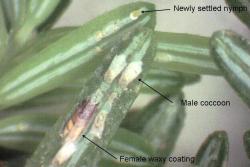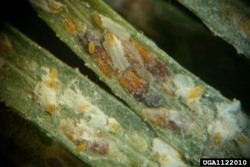Elongate Hemlock Scale—Fiorinia externa Ferris
Elongate hemlock scale (EHS)—Fiorinia externa Ferris, is a serious exotic pest of eastern hemlock (Tsuga canadensis). It also can be found on fir, spruce and other conifers. EHS attacks the surface of the hemlock needle and sucks out the fluid. This process causes the needles to turn yellow and drop prematurely.
EHS is found from Georgia and South Carolina, west to Ohio, Michigan and Minnesota and, north to southern New York and New England. In Maine, forest infestations of EHS have only been found in Kittery. Infestations on planted trees in Maine have been found from Kittery Point to Mt. Desert Island. It is probable that other areas of Maine have established populations of EHS.
Symptoms of elongate hemlock scale are yellow spots on the upper surface of infested needles and thinning of foliage. Signs include the scales on the undersides of host needles and waxy deposits created during the growing season. Mature females are covered with a brown, parallel-sided, waxy coating. During the growing season, males produce a white, waxy flocculence, which can also be found on the underside of the host needles.
In Maine, please report sightings of this pest to the Maine Forest Service.
Click on images to view full-size
Identification and Control Information
- Elongate Hemlock Scale—Maine Forest Service
- Elongate Hemlock Scale (PDF)—Penn State University
- Elongate Hemlock Scale (PDF)—USDA Forest Service
- Elongate Hemlock Scale—Penn State University
- Elongate Hemlock Scale—University of Vermont
- Elongate Hemlock Scale—University of New Hampshire Cooperative Extension
More Information
- Maine Forest Service: Conditions Reports (updated regularly) including annual summary reports
[Photos, left to right: Maine Forest Service; Eric R. Day, Virginia Polytechnic Institute and State University, Bugwood.org; Eric R. Day, Virginia Polytechnic Institute and State University, Bugwood.org]


